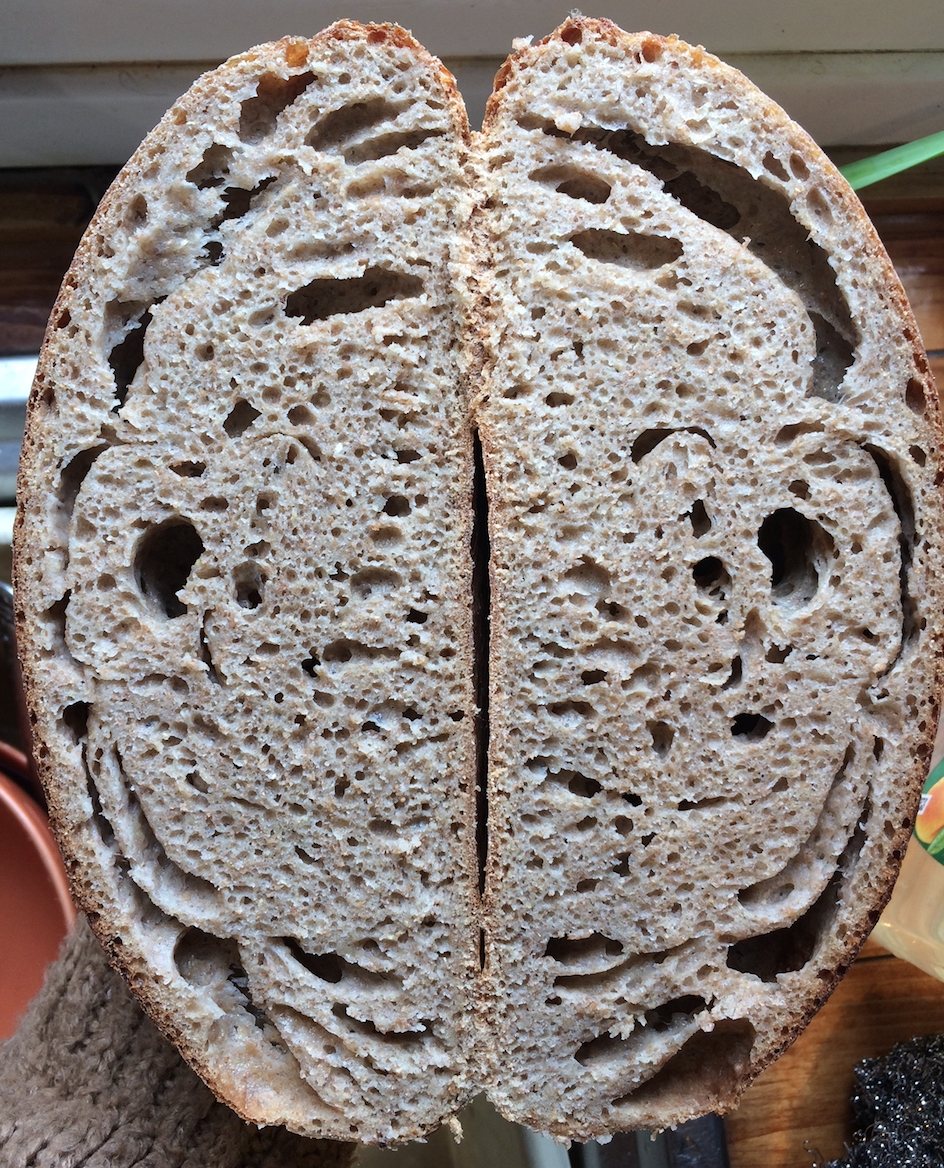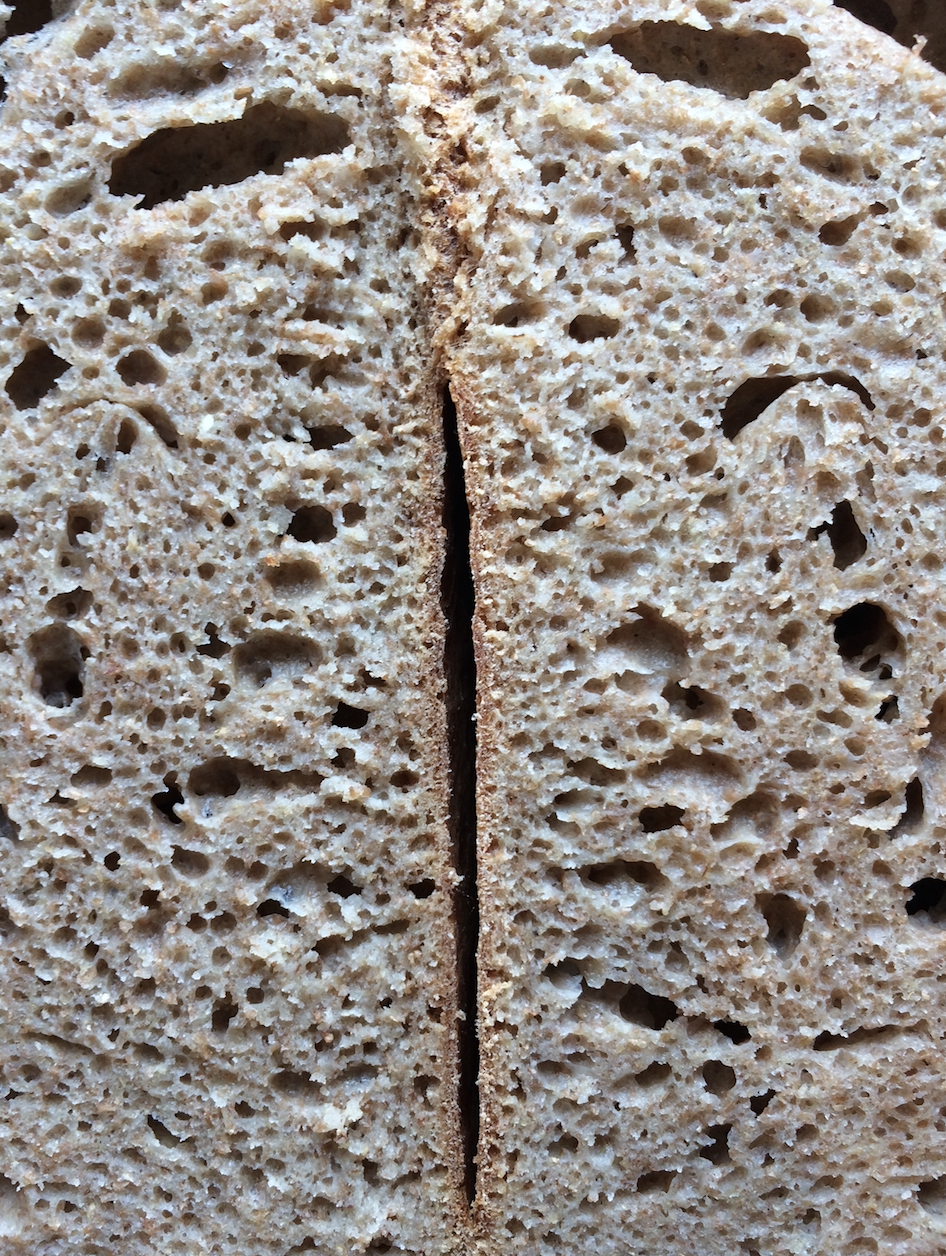RECIPE:
50% strong white flour (250g)
50% wholemeal flour (250g)
85% hydration (roughly)
15% starter (roughly)
2% salt
PROCESS:
9am: Refreshed starter with wholewheat
4pm: Autolyse flour + water
5.45pm: Mix in active starter & salt, on the bench, did some kneading till it felt sticky.
6.30pm: stretch & fold
7pm: stretch & fold
7.30pm: stretch & fold
8pm: stretch & fold
9pm: stretch & fold
10.30pm: shape, using a wet surface and no flour, and into fridge (proofed in baking paper in colander)
9.30am: out of fridge, preheat oven
10.15am: Straight from colander into dutch oven, still in baking paper. Baked at ~230C for 20 mins with lid on, 30 mins lid off
Left to sit for about 1 hour before slicing!
RESULT:
- A nice tasting loaf, with good level of fermentation and some rather large air holes (maybe a bit too big/irregular?)
- My main complaint is that the crumb felt a little gummy. Like, even cutting into it, it left quite a lot of sticky residue on the breadknife. This is quite a common problem with my breads - even when I leave them to sit overnight after baking - and I'm trying to get to the bottom of it.
- Let me know your thoughts!




- ninarosner's Blog
- Log in or register to post comments
Looking at the crumb I'm guessing thee issue here is under-proofing, maybe try one more hour fo bulk rise? It looks nice don't get me wrong but yeah the gummy texture is annoying. What kind of starter do you use? I mean how old and what ratio of seed-water-flour? Also is the bread sour at all?
My starter is about 2 months old, and rises predictably when I feed it. It's 100% hydration, and normally fed with wholewheat flour.
Also pierre, to answer your second question - it's not as sour as I would like, which is maybe a sign it's underproofed?
Nina, I admire your persistence! Went back read all accounts of your nine bakes, you are correct. Number 6 was by far the best.

My hunch is your starter. Please tell us everything you can about your feeding schedule.
Closeup photographs of your starter at maturity might be a great help. Gently stick a fork in the top of the starter and pull the top back to expose the insides. You should see long strands. If you can photograph that.
I may have asked you something similar before. I think so. If so, please forgive me. My memory has never been good.
Have you tried an all white bread and if you have how did it turn out?
You wrote, “Left to sit for about 1 hour before slicing!” No nearly long enough, especially for large percentages of whole wheat. If you slice into a loaf and it feels warm at all, you sliced too soon. The gummies will get ya’. I know it’s asking a lot, but most of my breads are sliced the following day. Wait at least 4 hours, if you can.
I sincerely hope that we can help you with your breads. You deserve a “smashing success”!
Danny
Thanks for the encouragement Dan, and for keeping track of my progress!
So, the starter:
refresh ratio (Starter + Water + Flour): I am never precise about the amount of starter left when I feed it. It's probably about three or four large tablespoons. I feed 50g flour and 50g water.
Type(s) flour: Usually wholewheat stoneground, but sometimes white stoneground. Again I am not 'fussy' about this (maybe I need to be)
Ambient Temperature (Very Important): I need to find out. I don't have a thermometer...
How do you determine it is time to refresh? Once it's risen and fallen, basically. Or worst case a bit of hooch.
Is the starter kept in the fridge? Yes.
How much does your starter increase by maturity? Do you mean how much it rises? I'd say it almost doubles.
I will photograph the starter next time I feed it and share with you!!
I have never tried all-white bread.
RE: slicing - I agree with you it's not enough time - however I tend to get some gumminess even when I leave it to cool overnight. Which makes me think it isn't a cooling problem... But I'm not helping myself by cutting into it after an hour.
Also Dan, I just posted Loaf 10 which might be of interest to you!
1. 85% might be too high hydration for only 50% WW. That might be the source of the gumminess issue.
2. Is your dutch oven preheated? Or are you putting the bread into a cold dutch oven?
3. Do you do a letter fold (left, right, top, bottom) before shaping? And if so, do you put the dough in the colander seam side up or down?
I'm suspecting that there's an issue with the way you fold/de-gas and shape.
1. Interesting... I'm planning on making 100% WW next (just because that's the only flour I have left at present) so I'll keep hydration the same and see what happens...
2. Yes, dutch oven heats up with the normal oven. So it's hot when the bread goes in. I should also say it's not a proper dutch oven. It's made of glazed ceramic, it's more like a heavy duty serving pot with a lid. But it seems to do the trick, building up steam.
3. Not with this bread, no. This is a kind of 'cheat' proof process which goes like this:
- Tip out onto surface after bulk rise
- Repeated folds from corners into centre (shaping into a boule)
- Flip over and increase tension by pulling underside of dough towards me on counter a few times
- Lift onto baking paper seam side down, then into colander to proof.
- After proofing, bread is transferred straight into dutch oven, still in its same baking paper. It remains seam side down.
Thank-you for the detailed and clear answers. I like the way you communicate.
Folding in from the "corners" versus the "sides" is likely accomplishing the same thing, so I don't see a problem there.
I suspect something is not happening correctly in the proof. But I'm unsure of what to suggest.
One idea is that your boule needs to be flipped at some point. The side that is against the walls of the "banneton"/colander is usually the "top" after transfer to the baking vessel. i think that is more important than whether the boule goes in the banneton seam up or seam down.
Since the holes along the top are not the "seam side", your folding procedure (the one immediately prior to shaping) is likely not responsible for them.
But the last stretch and fold of the bulk may be trapping air, and causing them, as that looks like it is done opposite the final "seam side."
Using a semi-slick baking paper instead of a floured towel/cloth or floured bare cane banneton is non-standard too, and is likely causing trouble as you are still learning. You're not getting the "wicking away" of moisture of the skin/loaf that standard procedures assume. So, you've changed this almost-essential element of the hearth-bread formula.
So here are suggestions to try, if they make sense to you:
1. limit it to three sets of stretch-and-folds, with the last set no later than 2 hrs into the bulk ferment. Doing S&F far into the bulk ferment seems out of the normal.
2. Use a tight-weave (flour sack type) of cloth or towel or kerchief instead of baking paper to proof. When I use a thin cloth/towel, I double it first. Something from your rag bin (laundered of course), like an old table cloth or pillow case, that kind of tight weave. And then flour/dust it with AP/Bread flour, or half rice flour and half AP/bread flour. If the dough sticks too much then it's too wet.
3. You can still flip it out of banneton/colander onto baking paper, and lower it into the baking vessel.
--
Possible under-proofing/over-proofing can be fixed by trial and error, expanding or reducing the ferment/proof times, or increasing/descreasing the amount of starter. BUT.... the starter has to be held consistent in terms of feeding schedule, amounts, temperature, and timings, especially the temp/time since last feeding. ("Room temp" varies seasonally, so the timing of starter at room-temp is generally determined by how much it rises, or when it first falls.) **Consistency** of those details, bake to bake, is much more important than what the details are. That consistency has to be held for at least 2 feedings prior to mixing dough. Otherwise, the number of viable organisms in that 70 grams of starter varies too much bake to bake. As you gain experience, you can make adjustments on the fly as you get to really understand your particular starter.
Sorry that this kind of rambles. ;-)
THANK YOU for all this info. I really appreciate you taking the time to help me along this journey :) So, don't apologise for rambling!
One idea is that your boule needs to be flipped at some point: I have done this with previous bakes, and was unsure as to whether it made the result better. So I was trying this 'cheat' approach but based on the rest of your answer, I think it might be causing me more problems.
But the last stretch and fold of the bulk may be trapping air, and causing them: this sounds right. I will limit the S&F as you suggest
Baking paper as opposed to floured towel: The truth is I've been wanting to buy myself some bannetons and do the whole thing 'properly'. The reason I haven't, is that I've been living somewhere temporary (housesitting) the last couple of months and I've been waiting till I'm more settled to get myself better baking equipment. So till then, I've been proofing in just a glass bowl or in this case, baking paper and colander. The one time I used a floured cloth and glass bowl, the dough stuck to it and it was really hard to tip out - but the cloth may have been the wrong type, unlike what you have described.
Starter: I must confess I've taken the casual approach in terms of feeding. I keep it in the fridge, but from now on I promise to be much more regimental about when and what I feed it!
P.S. I posted Loaf 10 a couple of hours ago if you want to check that out.